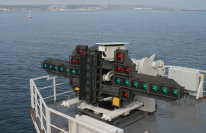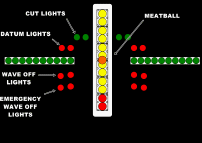NAVY GLADIATOR REUNION GROUP
USS Franklin D. Roosevelt


USS FRANKLIN D. ROOSEVELT was the second MIDWAY class aircraft carrier and the first ship in the Navy named after President Franklin
D. Roosevelt. Initially, the carrier was launched as CORAL SEA but was renamed FRANKLIN D. ROOSEVELT on May 8, 1945, following
the death of the US President. During her active service, the FRANKLIN D. ROOSEVELT achieved several historical milestones:
In 1945 she was the platform for the first fleet use of helicopters; in 1949 she became the first US aircraft carrier to have the
fresnel lens landing system (see article below) and she was the first carrier in the Navy to win three Admiral J.H.Flatley awards
for aviation safety.
Commissioned as CVB-42, the FDR was redesignated as attack aircraft carrier CVA-42 on October 1, 1952, and multi-purpose aircraft
carrier CV-42 on June 30, 1975. Decommissioned on September 30, 1977, and stricken from the Navy List the following day, theFRANKLIN D. ROOSEVELT was sold by the Defense Neutralization and Marketing Service (DRMS) for scrapping on April 1, 1978. The
carrier was last home ported in Mayport, Florida.
The 45,000-ton Midway class large aircraft carrier was built at the New York
Navy Yard. Commissioned on Navy day, 27 October 1945, she made a shakedown cruise to Brazil on February 1946. During April
and May of that year, she took part in Eighth Fleet maneuvers off the east coast, the Navy's first major post-World War II training
exercise. The first of Franklin D. Roosevelt's nearly two dozen deployments to the Mediterranean Sea followed in August-October.
Her second Med cruise began in July 1948 and lasted into early 1949. As the Cold War became increasingly tense in the late 1940's
and early 1050's, the carrier regularly crossed the Atlantic for operations with the Sixth Fleet off Southern Europe, carrying both
conventionally and nuclear-armed aircraft to deter the Soviet Union and its client states. She was reclassified as an attack
aircraft carrier in October 1952, changing her hull number from CVB-42 to CVA-42.
In early 1954, Franklin D. Roosevelt
steamed around Cape Horn to begin a two-year-long modernization on the west coast. When this work was completed, she was newly
equipped with an angled flight deck, "hurricane" bow, steam catapults and many other features that facilitated the operation of high-performance
aircraft. In November 1956, following her return to the east coast, Franklin D. Roosevelt made another cruise to European waters.
Over the next decade, she deployed to the Mediterranean another seven times, doing her part to provide a powerful and continuous U.S.
Navy presence in the often-troubled region. She recorded her 100,000th aircraft landing in March 1961.
From August 1966
to January 1967, Franklin D. Roosevelt made her only Western Pacific cruise, during which she conducted combat operations against
enemy targets in Southeast Asia. Her seventeenth Sixth Fleet tour followed in 1967-68, after which she entered the shipyard
for additional modernization work that gave her an additional deck-edge aircraft elevator, located forward of the island on the starboard
side.
Franklin D. Roosevelt returned to the Mediterranean six more times during 1970-77. Her twenty-first Sixth
Fleet deployment was marked by indirect participation on the October 1973 Middle East war, as she served as a transit landing "field"
for aircraft en route for delivery to Israel. She received another change in hull number, to CV-42, in June 1975. Franklin
D. Roosevelt completed her twenty-third, and final Mediterranean tour in April 1977. Decommissioned in October of that year,
she was sold for scrapping in April 1978.
FIGHTER SQUADRON SIXTY-TWO (VF-62)
Fighter Squadron Sixty-Two (VF-62), flying the F8F-2 Bearcat, was deployed onboard the USS Franklin
D. Roosevelt from 27 October 1949 to 23 November 1949 as part of Carrier Air Wing Six (CVG-6) attached to the U.S. Second Fleet.
During their deployment, the pilots of VF-62 participated in war operations in the North Atlantic.
Additionally, some (particularly later) optical landing systems include additional lamps:
- Cut lights — Green lamps used to signal different things based on where the approaching aircraft is in its approach. Early in a no-radio or "zip-lip" approach (which is routine in modern carrier operations), Cut Lights are flashed for approximately 2–3 seconds to indicate that the aircraft is cleared to continue the approach. Subsequent flashes of the Cut Lights are used to prompt the pilot to add power. The longer the lights are left on, the more power should be added. Cut Lights are operated manually by the LSO.
- Emergency wave-off lights - Red lamps that have the identical function as Wave-Off Lights, but use an alternate power source. Not normally used.
Light controls
Collectively, the apparatus that
the lights are mounted on is called “the lens”. It is turned on/off and brightness is adjusted at the lens itself for ground based
units, and remotely for shipboard units. In both cases, the lens is connected to a hand-controller (called the “pickle”) used by the
LSOs. The pickle has buttons that control the wave-off and cut lights.
Light mounting
Shipboard units mounted on the port side of the flight deck and are gyroscopically stabilized to compensate for ship movement. Additionally, shipboard units are mechanically moved (the “roll angle”) to adjust the touchdown point of each aircraft. With this adjustment, the tailhook touchdown point can be precisely targeted based on the tailhook-to-pilot’s eye distance for each aircraft type.


OPTICAL LANDING SYSTEM (OLS)
An optical landing system (OLS), often referred to as the "Ball" or "Meatball", is used to give
glidepath information to pilots in the terminal phase of landing on an aircraft carrier. From the beginning of aircraft landing
on ships in the 1920s to the introduction of OLSs, pilots relied solely on their visual perception of the landing area and the aid
of the Landing Signal Officer (LSO). LSO's used colored flags, cloth paddles and lighted wands to help guide the pilots
to a safe landing.
The first OLS was the mirror landing aid, one of several British inventions made after the Second World War revolutionising
the design of aircraft carriers. This was a gyroscopically-controlled concave mirror mounted on the port side of the flight
deck. On either side of the mirror was a line of green coloured "datum lights". A bright orange "source" light was shone into the
mirror creating the "ball" (or "meatball") which could be seen by the aviator who was about to land. The position of the ball compared
to the datum lights indicated the aircraft's position in relation to the desired glidepath: if the ball was above the datum, the plane
was high; below the datum, the plane was low; between the datum, the plane was on glidepath. The gyro stabilisation compensated for
much of the movement of the flight deck due to the sea, giving a constant glidepath.
Later systems kept the same basic function
of the mirror landing aid, but upgraded components and functionality. The concave mirror, source light combination was replaced with
a series of fresnel lenses. The fresnel lense reduces the amount of material required compared to a conventional lens
by dividing the lens into a set of concentric annular sections resulting in a thinner, lighter lens.
An optical landing
system has several related components: the lights used to give visual cues to approaching aircraft, the light control system, and
the mounting system.
Lights
Regardless of the actual technology, at lest three sets of lights are used;
- Datum lights — a horizontal row of green lamps used to give the pilot a reference against which he may judge his position relative to the glide slope.
- Ball (or “meatball”; also known as "the source") — indicates the relative position of the aircraft with reference to glide slope. If the aircraft is high, the ball will be above the datum lights; if the aircraft is low, the ball will be similarly below the datums. The further the aircraft is from the glide slope, the further the ball will be above or below the datum lights. If the aircraft gets dangerously low, the ball appears red. If the aircraft gets too high, the ball appears to go off the top.
- Wave-off lights — red flashing lamps which, when lit, indicate that the pilot must add full power and go around — a mandatory command. When the wave-off lights are lit, all other lamps are extinguished. The wave-off lights are operated manually by the LSO.